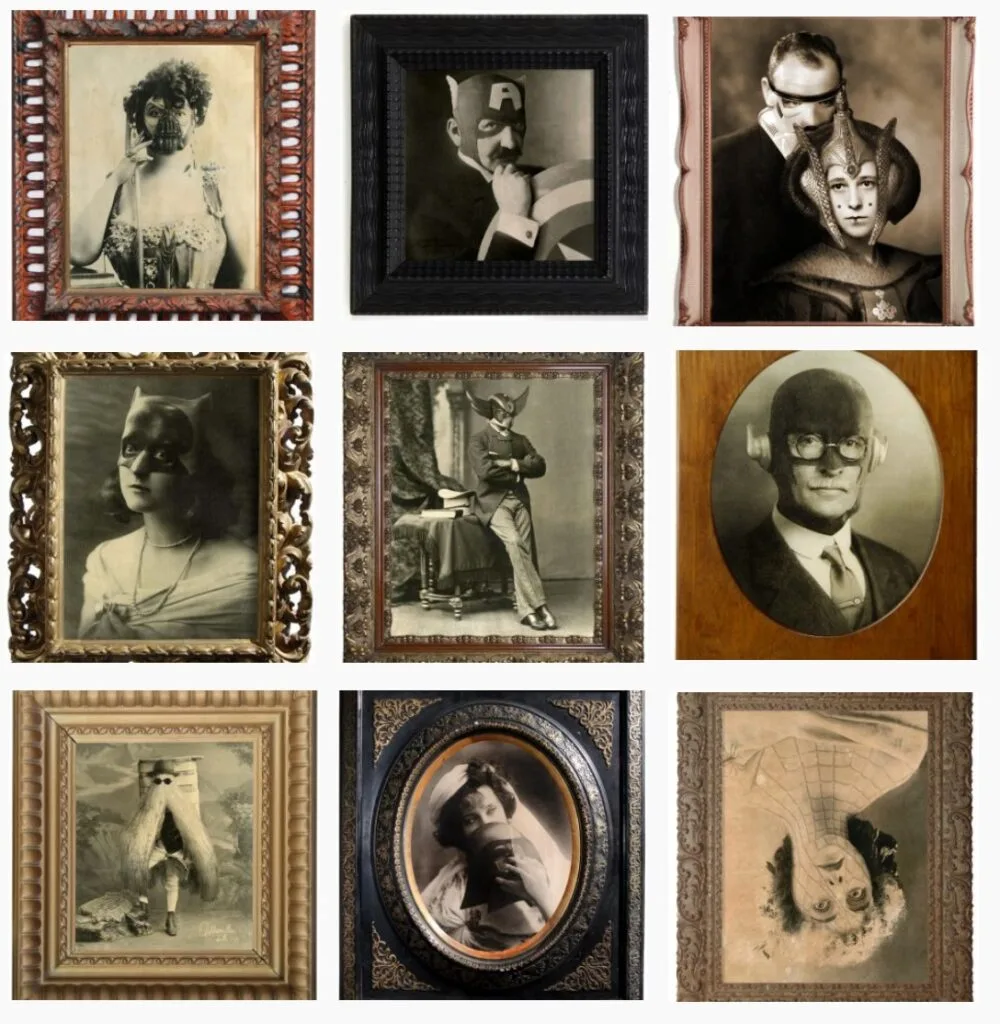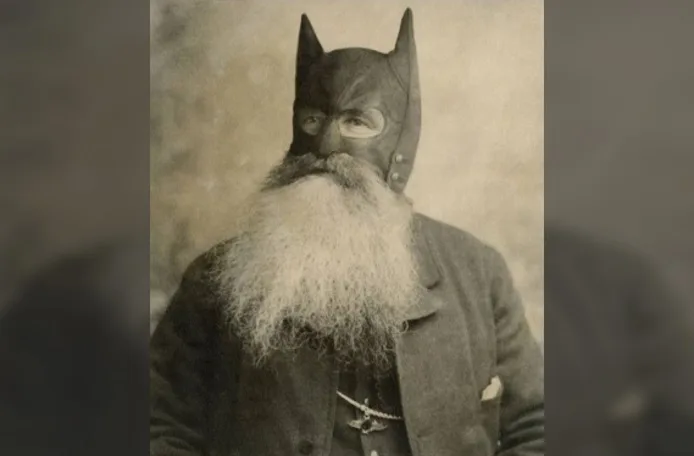For several years, posts have been circulating on the Internet that the image of a superhero from comics was based on the story of a real person who, back in the 19th century, fought crime in New York wearing a bat mask. We checked the photo and story for accuracy.
On social networks you can often come across posts with an old photograph of a bearded man wearing a dark mask with ears on his head. If you believe such publications, the photo was taken in 1892 in New York. It allegedly depicts a man named William Smith, who emigrated to the United States from Suffolk, England, and began working as a butcher. Smith reportedly beat up shoplifters and also made a mask in the shape of a bat and patrolled the streets at night. Moreover, he allegedly even had an assistant named Robin, thanks to whose diaries it became known that all the criminals in the area knew about the fighter against thieves nicknamed Batman.
On VKontakte, posts about the real 19th century Batman began to spread massively in 2020. For example, in the public “Pipe of War” they wrote about the “historical prototype” of the superhero three times (here, here And here) - a total of 66,000 views, 1,100 likes and 740 reposts. There are also other posts with hundreds of likes and tens of thousands of views (here, here And here). The life story of Bill Smith is found in Telegram channels such as “Lost past"(207,000 views), Lost (72,000), "History of the past" (68,000) and "Forgotten History" (twice: 68,000 And 59,000), V Facebook*, "Zene", to "Odnoklassniki"and also some entertaining And news websites.
If you write Suffolk Batman in a search engine, then one of the first results will be the Suffolk Gazette website, where there is material about Smith came out back on December 4, 2016. According to the text, the newspaper's editors allegedly conducted a journalistic investigation and found out that the image of the popular DC comics superhero was based on a native of Suffolk. Since translations in Russian have been circulating on the Internet for several years and during this time they have acquired various details, we provide a translation of the original article under the title “The original Batman was a fat old man with a beard.”
In Hollywood, he is portrayed as a muscular superhero who is idolized by millions of fans around the world, but we can reveal that the original Batman was a fat old man with a bushy beard.
Until now, it was believed that Batman was created entirely by DC Comics in 1939, received his own television series in the 1960s, and then began the cult film franchise in 1989. But an investigation by the Suffolk Gazette revealed that the character was inspired by the true story of Bill Smith, who moved to America from Suffolk, England, in 1870 and settled in New York, where he worked in a butcher shop.
We examined historical records in East Anglia and the US to piece together the amazing story of how Smith became a vigilante due to repeated attacks on his shop by thieves. According to city records, Smith's first charge was in 1878 for catching and beating a thief who ran out of a store with a leg of lamb over his shoulder. At the time, Smith, 43, was released by a sympathetic judge who was no doubt fed up with the never-ending list of petty criminals he had to deal with.
The incident inspired Smith, who, according to parish records, had previously left Dallingha in Suffolk, where he worked as a farmhand, and taken a liner from Liverpool to New York in search of a better life. Inspired by a short article about his trial in the New-York Tribune, he continued to fight other thieves and soon became infamous as a vigilant. It took another four years before he began wearing his famous mask on his head to resemble a bat and hide his true identity. He then patrolled the area at night looking for criminals.
Excerpts from a diary written in 1892 by an associate known only as Robin (also name is Batman's sidekick in the comics. — Approx. ed.), include an exclusive photo, which we are publishing for the first time today. The diary says: “Everyone in the area has heard about this Batman. He walks the streets at night, and bandits, thieves, drunkards and tramps stay away from him.” And it is added: “He is vengeance. He is the night. He's Batman."
But the story of the original Batman ends there, and the only remaining document about Smith is his death certificate. We obtained a copy from the New York Central Archives and it says he died at the age of 66 from hypothermia after being left alone on the street on a freezing night in February 1896.
So, it is now clear that the creators of the Batman character for DC Comics, Rob Kane and Bill Finger, based him on the local legend of Bill Smith. And when you watch the next Batman movie with your family, you can tell them that Batman actually worked on a farm in Suffolk, England.
After reading, you might really get the impression that comic book authors knew about Smith back in the 30s of the 20th century. However, if you look at the description of the newspaper, you can be convinced that this is all just fiction. “The Suffolk [Gazette] is full of weird and wonderful stories and, although our stories are clearly satirical, they are reprinted by gullible major media outlets including Sky News and national newspapers,” reads text on the “About Us” page. Although the satirical nature of the materials was not explicitly stated in the project description until end 2020, there were obvious hints. Thus, the site’s slogan is “You couldn’t make it up,” which can be literally translated into Russian as “You couldn’t come up with it.” In addition, among the employees indicated people with meaningful names: for example, the editor of the crime section is called Rob Banks (Rob Banks sounds like the phrase “rob banks”), and Polly Ticks is responsible for the politics section.
The question remains: what kind of person is shown in the viral photo wearing a bat mask?
Over the years, fact checkers and journalists from USA, Kazakhstan, Portugal, Peru And Mexico (summer 2020 story by Bill Smith flew around многие страны Латинской Америки). They found out that the original photo was created by a photo workshop Foto Marvellini, based in 2011. On the workshop website there is a photo of a bearded Batman called Batbarbone, and the description states how the work was done: “Paper based on cotton fiber with silver salts. Printed in a dark room and treated with tannic acid. Housed in a wooden frame dating to approximately the early 1900s." On the studio's Facebook, a photo of a bearded Batman is avatar profile, and in the gallery on the website presented other works in which people from different eras wear masks that reference science fiction works.

Brothers Andrea and Carlo Marvellini from Foto Marvellini confirmed Snopes said that Batbarbone is their original work, created in 2012. They digitally manipulated photographs from the 1860s and 1890s from the Library of Congress, adding masks. At the same time, photographers refuse from the term “fake,” arguing that “with their deliberately deceptive works, they invite viewers to remember that photographs as a whole, by their nature, evoke and shape emotions and understanding of the world.”
As for Batman's real inspirations, artist Bob Kane is one of them. called the films The Mark of Zorro (1920) and Whispers of the Bat (1930), as well as the radio drama The Shadow and the flying machines of Leonardo Da Vinci. However, many of the costume's iconic details, such as the hood with ears, white eyes without pupils, the long cloak and gloves, were suggested by screenwriter Bill Finger. Character debuted in Detective Comics #27 in 1939.
*Russian authorities think Meta Platforms Inc., which owns the social network Facebook, is an extremist organization; its activities in Russia are prohibited.
Cover photo: Foto Marvellini
Satirical news
- Is it true that the photograph depicts a god from Mayan mythology?
- Is it true that the photo shows a man who stepped on his beard and broke his neck as a result?
- Is it true that the photo shows a 19th century wig seller?
- The Fictional World of Gek Publics (VMGP)
If you find a spelling or grammatical error, please let us know by highlighting the error text and clicking Ctrl+Enter.






